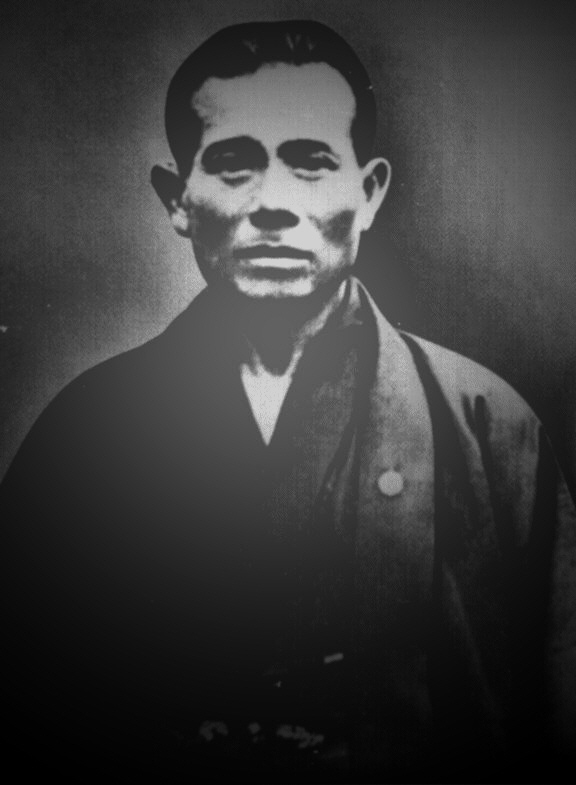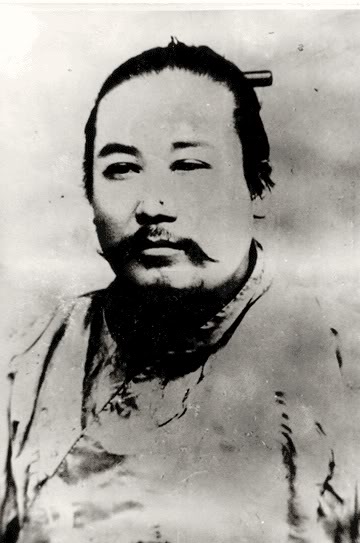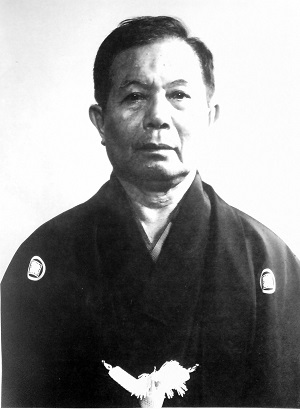A Brief History of Uechi Ryu
Kanbun Uechi was born in Izumi, Okinawa on May 5th, 1877. His family were daikon radish farmers who could trace their lineage back to a family of samurai. Kanbun grew up working on the farm and developing an interest in martial arts, particularly in Chinese fighting systems. At the time, China was the best place to go for intensive training.
In 1897, Kanbun had the opportunity to realize his dream of studying under a Chinese master—though under stressful circumstances. Japan had begun a military conscription program in Okinawa, and at the age of 19, Kanbun would have been eligible. To escape the Japanese draft, he fled to Fuzhou in Fukien Province, China. Once there, he began studying karate with Matsuda Tokusaburo, another Okinawan who had escaped to China, but this period of study was short-lived due to mistreatment by one of the dojo instructors.
Kanbun next studied under Zhou Zihe/Chou Tzu-Ho (Shu Shiwa in Japanese). Shu Shiwa was an instructor of a Kung Fu system called Pangai-noon, or Pangainun. Not much is known about Shu Shiwa, but research indicates that he was born in the Zhitian Village in 1874, to a wealthy family. He served as Kanbun’s Pangai-noon instructor for a total of 13 years.
Pangai-noon had movements based on the tiger, crane, and dragon. It was a fusion of two different styles: Southern Shaolin Ken, an offensive and hard-bodied sect of Chinese kempo, and Eishu Ken, a softer, more defensive-oriented style. The style was therefore known as being “half-hard, half-soft style.” This descriptor of “half-hard, half soft” still applies to Uechi-Ryu today, and the tiger, crane, and dragon are still referenced as the three animals of the style.
It is said that Kanbun Uechi spent his first three years of study doing chores around the dojo and practicing nothing but Sanchin (lit. “three conflicts”), the style’s foundational kata. It was only after this time that Shu Shiwa agreed to formally teach him—a rare privilege for an outsider. Kanbun went on to learn the other two original kata of the style: Seisan and Sanseirui. After ten years of study, Kanbun received his teaching license and opened his own dojo in Nanjing in 1906. Even while teaching others, he continued his own training with Shu Shiwa over the next three years.
Unfortunately, this arrangement wouldn’t last. When one of Kanbun’s Chinese students killed a neighbor in a dispute over land irrigation, using a technique Kanbun had taught him, Kanbun decided to close his school and return to Okinawa. He was determined to never teach again.
For a time, Kanbun was true to his word. He became a farmer, got married, and refused to teach martial arts once he resettled in Okinawa, despite multiple requests. During this time, Kanbun focused on his family. His first child, Kanei Uechi, was born on June 26th, 1911. Kanbun Uechi would go on to have four children in total: two sons, Kanei and Kansai, and two daughters, Tsuru and Kamai.
This quiet time in Kanbun’s life came to and end around 1924. Due to economic conditions in Okinawa, Kanbun left his family and moved to the Wakayama Prefecture in Japan to find work. While there, he was persuaded by Ryuyu Tomoyose to teach private lessons. After two years of privately teaching, Kanbun had a small group of students, whom he taught before and after work as well as during lunchtime. One of these students was his own son, Kanei, who moved to Wakayama in 1927. In 1932, Kanbun opened a small general store and dojo, which he called the “Pangai-noon Ryu Karate Academy.”
Pangai-noon was renamed to Uechi-Ryu, in Kanbun’s honor, in 1940. By this time, Kanbun’s son Kanei had established his own dojo in Osaka. This dojo was later relocated to Amagasaki, in the Hyogo Prefecture. Kanei returned to Okinawa in 1942. Kanbun, however, continued to teach in Wakayama until 1946, at which time he returned to Okinawa and settled on the island of Iejima, where he died of nephritis—also known as Bright’s disease—on November 25th, 1948, at the age of 71. Although Bright’s disease was treatable at the time, it is said that Kanbun refused medical treatment during the last year of his life, believing a fortune teller’s prophecy which stated he would not die until he was 79 years old.
After Kanbun’s death, Kanei continued to teach Uechi-Ryu. With Ryuyu Tomoyose’s son, Ryuko, he opened two dojos in 1949. These were later combined in 1957. A year later, instructors were teaching the public, including American G.I.’s such as George Mattson, the first American to receive a black belt in the style. Uechi-Ryu is one of the first styles of karate taught to foreigners, and Mattson was instrumental in popularizing the style in the United States.
Throughout his life, Kanei Uechi worked to systemize his father’s style. He worked tirelessly to help new students understand Uechi-Ryu, working with his students to develop warm-up and stretching exercises, two-person kumites, and five “bridging” kata to supplement the style’s original three.
In 1987, Kanei was hospitalized for a stomach ailment, from which he never fully recovered. After years of hospital visits, he died on February 24th, 1991.
The popularity of Uechi-Ryu has continued to grow, particularly due to its emphasis on self-defense and its relative simplicity in comparison to other styles. Today, more than two dozen independent groups administer groups of dojos and certify instructors and dan (black belt) ranks. Fourth Form Martial Arts is affiliated with the Okikukai Organization, which has its headquarters in Okinawa and is headed by senior students of Kanei Uechi.

Kanbun Uechi, Founder of Uechi-Ryu

Shushiwa, Kanbun Uechi’s instructor

Kanei Uechi, Kanbun Uechi’s son.
A Brief History of Fourth Form Martial Arts Studio
The story of Fourth Form begins with Allen Horton, a student of Ryuko Tomoyose. In the early 1960s, Horton began teaching Uechi-Ryu in Kalamazoo, Michigan. One of his students, William Keith, soon took up teaching in the area before bequeathing his dojo to James Thompson, a student of both Kanei Uechi and Ryuko Tomoyose, in the 1980s.
Uechi-Ryu came to Grand Rapids when Donald Joyner, who studied under William Keith and James Thompson, opened Joyner’s Professional Karate in 1991. He ran the dojo until 2003, when he sold the dojo to his student, Jon Olson. Jon Olson then renamed the dojo to East West Karate Center.
East West Karate was active from 2003-2020, and during that time it passed through multiple owners. Aside from Jon Olson, instructors that taught at East West included Michelle Kutcha, Muhamet Vitia, and Chris Cohee—all of whom were students of Don’s. It was during this time that Allison Hawkins, Fourth Form’s eventual owner, began studying Uechi-Ryu.
Jon Olson, East West‘s first owner, later sold the business to Chris Cohee, who in turn sold it to George Guyott and Muhamet Vitia. During George and Muhamet’s ownership, Allison, after a twelve-year absence from Grand Rapids and from the style, decided to resume her practice of Uechi-Ryu and continue her martial arts journey.
When the COVID-19 pandemic lockdowns first went into effect in March of 2020, no one knew how long the restrictions would last. Under Sensei Chris, East West Karate students began meeting up at local parks to train safely when they were able. Once the winter months hit, the group moved to an indoor racquetball court and began their search for a new, more permanent place to call home.
With encouragement and support from her Senseis and fellow students, Allison took the lead on business ownership. Rather than purchasing East West Karate, she decided to form a new business to signify the beginning of a new chapter. In January of 2022, Fourth Form Martial Arts Studio officially opened its doors to the public, continuing the legacy of Uechi-Ryu study in Grand Rapids.
Uechi-Ryu Timeline of Events
1874: Zhou Zihe/Chou Tzu-Ho (Shu Shiwa) is born in Zhitian Province in China, to a wealthy family.
1877: Kanbun Uechi is born on May 5th in Izumi, Okinawa, to a farming family with samurai lineage.
1897: Kanbun flees to Fukien Province in southern China to study martial arts and to avoid the Japanese military draft in Okinawa.
1897-1910: Kanbun studies Pangai-noon, a kung-fun style, under Shu Shiwa.
1906-1910: Kanbun opens his own dojo in Nanjing, China and teaches students Pangai-noon. He continues to visit Shu Shiwa to continue his own training during this time.
1910: After a technique is misapplied by one of his students, Kanbun returns to Izumi, Okinawa and vows never to teach again. He becomes a farmer and gets married.
1911: Kanbun’s eldest son, Kanei Uechi, is born on June 26th
1924: Kanbun moves to the Wakayama Prefecture, on the Japanese mainland, for work.
1926: Shu Shiwa dies in China.
1927: Ryuyu Tomoyose finds out about Kanbun’s martial arts training and convinces Kanbun to give him private lessons. Kanei Uechi starts learning Pangai-noon.
1932: Kanbun opens a general store and dojo, where he’ll continue to teach until 1946.
1937: Kanei opens his own dojo in Osaka. This dojo will later be relocated to Amagasaki.
1940: The style is officially renamed from Pangai-noon to Uechi-Ryu, in Kanbun’s honor.
1942: Kanei returns to Okinawa.
1946: Kanbun returns to Okinawa and settles on the island of Iejima.
1948: Kanbun Uechi dies of Bright’s disease on November 25th, at the age of 71.
1949: Kanei Uechi and Ryuko Tomoyose (the son of Ryuyu Tomoyose) open two dojos. These two dojos are combined into one dojo in 1957.
1958: Uechi-Ryu starts being taught to the public, including to American servicemen.
1958-1991: Kanei organizes his father’s system, formalizing it in a way that’s more approachable. He develops three bridging kata to supplement the style’s original three katas. He also establishes the first Dan tests.
1987 – Kanei is hospitalized for a stomach ailment, from which he never fully recovers.
1991 – Kanei Uechi dies on February 24th.